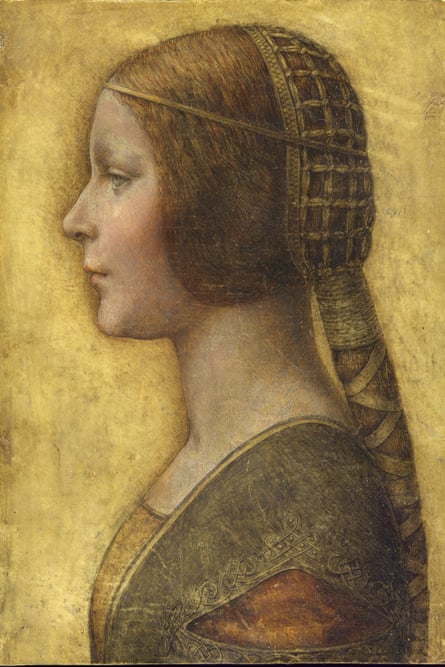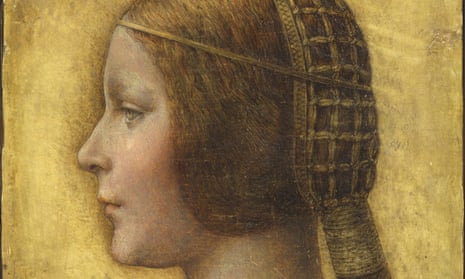“Truly celestial was Leonardo da Vinci,” said the 16th-century art writer Giorgio Vasari. That verdict has stood for centuries. No one has ever doubted Leonardo’s genius, and in our own time his fame is greater than ever. We should probably therefore have some sympathy for experts so besotted with his name, fame and magic that they foolishly declared an obvious fake to be the real thing.
La Bella Principessa is a profile portrait of a young woman in late 15th-century dress with her copper hair flattened down at the sides and worked behind into an elaborately bound ponytail. Her skin is pink, her gaze cool – or bored. Martin Kemp, one of the world’s most renowned Leonardo authorities and emeritus professor of the History of Art at Oxford, hailed it as a rediscovered marvel in his 2010 book La Bella Principessa: the Story of the New Masterpiece by Leonardo da Vinci. Museums and other experts have backed Kemp’s claim.
What a wondrous thing: a newly attributed portrait by the man who painted the Mona Lisa – but the principessa might not be quite so bella after all. She may, in fact, be Sally from the Co-op. Convicted art forger Shaun Greenhalgh claims that he faked this “Leonardo” and that the model is a girl he knew in Bolton in 1975.
I have no idea whether or not Greenhalgh – jailed in 2007 for other art forgeries – really created this ugly pastiche. But I am absolutely certain that it has nothing to do with Leonardo da Vinci.
This really is a sorry tale, a revelation of how the most famous and justly revered artist in the world has become the centre of an inflated industry where everything than can remotely be connected with him is hyped to insane degrees of exaggeration or wishful thinking. It is also a warning of the dangers of scientific analysis replacing the good old human eye. For the claim that La Bella Principessa is a genuine Leonardo rests on testing its paper and materials – which apparently date it to at least 250 years ago.
That’s 250 years before Greenhalgh – but 250 years after Leonardo.

I could buy that. Perhaps La Bella Principessa was created as a fake Leonardo in about 1650. Leonardo was already very famous then and his works were in huge demand; that’s the era when the British royal family bought his greatest drawings. They also had very few ways of authenticating art so long ago. A 17th-century painting of Medusa in the Uffizi was mistaken for a Leonardo until modern times.
Whenever and by whoever it was forged, La Bella Principessa is not a Leonardo. I honestly don’t know how anyone who loves his art could make that mistake. There is a deadness to this woman’s eye, a coldness to the way she is posed and drawn that has no resemblance to Leonardo da Vinci’s energy or vitality. She looks so miserable she may well be on a break from working at a Bolton supermarket in the 1970s.
This is a bad artist’s impression of the Leonardo style. That hairpiece with its complex banding is “Leonardesque” – he loved to dress women in fine garments that I suspect he designed himself. But it’s too clumsy, too crude to be a real Leonardo conception; at best, it could be a clumsy copy of a lost Leonardo original.
The real giveaway is the total absence of an emotional dynamic between this young woman and Leonardo da Vinci. She just sits there, waiting, as if she was posing in a passport photobooth. There is no chemistry and no sense of personality.
These are the very qualities that make Leonardo’s real portraits so exciting and insightful. Vasari claimed he got the Mona Lisa to smile by having musicians and jesters entertain her. More likely, I think, Leonardo himself got on well with women and they are in on the mystery of his portraits. For it is not just the Mona Lisa who has such a dynamic relationship with her onlookers, teasing us with that enigmatic smile. In his early portrait of Ginevra de’ Benci, Leonardo almost fills the panel with her sad, reflective, big-eyed face. She is a sensitive soul directly engaging the onlooker in her poetic reverie.
Less reflective and more straightforwardly sexy is The Lady with an Ermine, stroking a rather phallic pet, as she turns subtly with a half smile as if greeting her lover. This painting goes out of its way to suggest erotic drama and emotional games. Leonardo’s portraits are miracles of theatricality, and that’s before you even consider his unbelievably sensitive drawing, exquisite colouring and infinitely perceptive rendering of real human bodies – none of which La Bella Principessa has.
The most damning comparison is Leonardo’s most superficially similar work, a profile drawing of Isabella d’Este, Renaissance woman and ruler of Mantua, that is in the Louvre. This may be the inspiration for whoever did La Bella Principessa, but the gulf is so vast between the real thing and the fake. Leonardo makes Isabella warm and passionate and full of energy and intelligence – even uncoloured, she glows. La Bella Principessa is just flat and dead and dull.
Leonardo da Vinci loved women and he worked hard to give them portraits they deserved. La Bella Principessa is a lifeless fake that has none of his vision or delicacy. Personally it looks to me like a Victorian knock-up. The artists may even have based it on a photograph.
She may even be Sally from the Co-op. She ain’t no Leonardo, that’s for sure.

